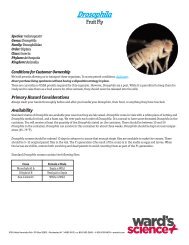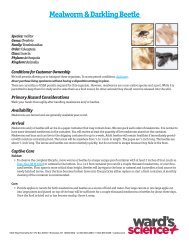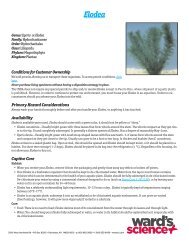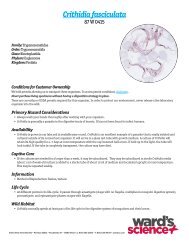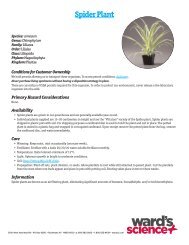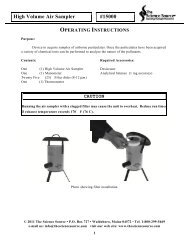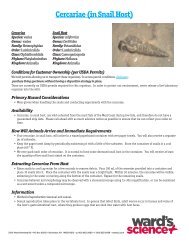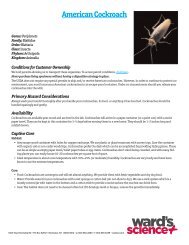Madagascar Giant Hissing Cockroach - Ward's Science
Madagascar Giant Hissing Cockroach - Ward's Science
Madagascar Giant Hissing Cockroach - Ward's Science
You also want an ePaper? Increase the reach of your titles
YUMPU automatically turns print PDFs into web optimized ePapers that Google loves.
<strong>Madagascar</strong> <strong>Giant</strong> <strong>Hissing</strong> <strong>Cockroach</strong><br />
Genus: Gromphadorhina<br />
Family: Blaberidae<br />
Order: Dictyoptera<br />
Class: Insecta<br />
Phylum: Arthripoda<br />
Kingdom: Animalia<br />
Conditions for Customer Ownership<br />
We hold permits allowing us to transport these organisms. To access permit conditions, click here.<br />
Never purchase living specimens without having a disposition strategy in place.<br />
The USDA does not require any special permits to ship and/or receive <strong>Hissing</strong> <strong>Cockroach</strong>es; however, in order to continue to protect our<br />
environment, you must house your <strong>Hissing</strong> cockroaches in an escape-proof container. Under no circumstances should you release your<br />
cockroaches into the wild! This is not a species native to North America.<br />
Primary Hazard Considerations<br />
Always wash your hands thoroughly after you handle your cockroaches, its food, or anything it has touched. <strong>Hissing</strong> cockroaches have<br />
sharp spurs on their legs that can snag on rough skin, so some people prefer to handle them while wearing gloves.<br />
Availability<br />
<strong>Hissing</strong> cockroaches are available year round, since they are bred in the lab. <strong>Cockroach</strong>es will arrive in a paper container with moist paper<br />
towel, and can survive in the shipping container for 3–5 days at room temperature. <strong>Hissing</strong> cockroaches are large roaches and can reach<br />
2–3 inches in length.<br />
Captive Care<br />
Habitat:<br />
• Any escape-proof container with holes for oxygen exchange. We use plastic or glass Terrariums 21 W 2101 with ventilated tops. Line<br />
the container with organic soil or non-cedar wood chips. <strong>Cockroach</strong>es prefer the dark which can be accomplished by providing hiding<br />
places. These can be as simple as empty paper towel/toilet paper tubes or egg crates. <strong>Cockroach</strong>es don’t mind being crowded, and<br />
with many hiding places you can easily house 10–20 cockroaches per square foot of space.<br />
• Ideal temperature is about room temperature with 35%–45% (or moderate) humidity.<br />
Care:<br />
• Food: <strong>Cockroach</strong>es are scavengers and will eat almost anything. We provide them with fresh vegetables and dry dog food.<br />
• Water: Provide water for your cockroaches with a wet sponge or cotton ball (do not allow to dry). We use a wick system which is a<br />
loosely covered jar with water in the bottom and a cotton wick to provide a moist surface the roaches can drink from.<br />
• Care: Habitat does not need to be cleaned often but if it develops mold or fungus, remove the growths immediately.<br />
If you should see any mites on your cockroach these should be removed immediately. These mites are parasitic to the roach (and<br />
harmless to humans). To remove the mites, briefly hold your cockroach under running water, giving it a “bath,” and return it to a<br />
cleaned habitat with fresh substrate.<br />
Information<br />
• Method of Reproduction: Sexual. Female retains fertilized eggs internally and gives live birth.<br />
• Determining sex: Male: Males have pronatal humps (horn-like protrusions) located on thorax, with bushy antennae that point<br />
upward and a short stocky abdomen. Females: Females have small or no bumps on thorax, with short thin antennae that point<br />
downward and a long slender abdomen.
Life Cycle<br />
• Egg: contained in a case called an ootheca which is retained in the body of the mother for about three months.<br />
• Nymph: molts approx. six times in 5–10 months before becoming sexually mature (an adult).<br />
• Adult: (This is the form you receive) The adult hissing cockroach has a lifespan of about 1–3 years and can reach 4–7 cm long.<br />
Wild Habitat<br />
• <strong>Hissing</strong> cockroaches are originally from <strong>Madagascar</strong>, an island off the coast of Africa with a tropical/subtropical environment. In the<br />
wild, they forage on the forest floor eating mostly fallen fruits and decaying wood. Birds, mammals, reptiles, amphibians, and even<br />
other insects are predators that will eat the giant cockroach.<br />
Special Notes<br />
During aggressive encounters, courtships, and disturbances, the cockroach will produce it’s signature hiss. The hiss does not come from<br />
the cockroach’s mouth. This hissing sound is actually created by expelling air from its abdominal spiracles or breathing pores.<br />
Disposition<br />
• We do not recommend releasing any laboratory animal into the wild, and especially not insects that are considered to be pests or not<br />
native to the environment.<br />
• Adoption is the preferred disposition for any living animal.<br />
• If the insects must be euthanized at the end of study, follow one of these procedures:<br />
• Put them into a container or bag and freeze for 48 hours.<br />
• Place the organism in 70% isopropyl alcohol for 24 hours.<br />
• Autoclave the organism @ 121°C for 15 minutes.<br />
• A deceased specimen should be disposed of as soon as possible. Consult your school’s recommended procedures for disposal. In<br />
general, dead insects should be handled as little as possible or with gloves, wrapped in an opaque plastic bag that is sealed (tied<br />
tightly) before being placed in a general garbage container away from students.<br />
© 2008 Ward’ s <strong>Science</strong>. All rights reserved. Rev. 9/08, 11/09, 3/13



